V2B/V2G on Energy Cost and Battery Degradation under Different Driving Scenarios, Peak Shaving, and Frequency Regulations
Abstract
:1. Introduction
2. Materials and Methods
2.1. Electricity Bill Calculation
2.2. Problem Formulation
- To find the optimal policy and strategies for using the energy stored in EV batteries to reduce the total energy cost H of the building owner.
- To find the SoC optimal range of EV batteries with slow battery degradation, while providing building load supply when necessary, powertrain for the EV, peak shaving and frequency regulation simultaneously.
2.3. Peak Shaving
2.4. EV Battery Model and Degradation Cost
2.5. Frequency Regulations
2.6. Multi-objective Optimization
- -
- Minimize EV’s owner electricity bill
- -
- Such that
- ○
- The gain from selling EV energy to building owner is maximized.
- ○
- Minimize battery degradation thus minimize battery cost.
- ○
- Keep SoC within SoCmin < SoC < SoCmax.
2.7. Simulation Strategy
3. Results
3.1. EV Owner and Household Bill
3.2. Electricity Bill for Building Owner
4. Discussion
5. Conclusions
Author Contributions
Funding
Acknowledgments
Conflicts of Interest
References
- Electric Vehicle Outlook 2017; Bloomberg New Energy Finance: New York, NY, USA, 2017.
- Pike Research Report on Vehicle to Building Technologies; Pike Research: Pikes Peak, CL, USA, 2012.
- Motors, T. Tesla Model S Specifications. Available online: https://www.teslamotors.com/en_CA/support/model-s-specifications (accessed on 30 September 2015).
- Walawalkar, R.; Apt, J.; Mancini, R. Economics of electric energy storage for energy arbitrage and regulation in New York. Energy Policy 2007, 35, 2558–2568. [Google Scholar] [CrossRef]
- White, C.D.; Zhang, K.M. Using vehicle-to-grid technology for frequency regulation and peak-load reduction. J. Power Sources 2011, 196, 3972–3980. [Google Scholar] [CrossRef]
- Xi, X.; Sioshansi, R.; Marano, V. A stochastic dynamic programming model for co-optimization of distributed energy storage. Energy Syst. 2014, 5, 475–505. [Google Scholar] [CrossRef]
- Cheng, B.; Powell, W. Co-optimizing battery storage for the frequency regulation and energy arbitrage using multi-scale dynamic programming. IEEE Trans. Smart Grid 2018, 9, 1997–2005. [Google Scholar] [CrossRef]
- Shi, Y.; Xu, B.; Wang, D. Zhang, B. Using battery storage for peak shaving and frequency regulation: Joint optimization for superlinear gains. arXiv 2017, arXiv:1702.08065v3. [Google Scholar]
- Intro to Demand Charge Management. Available online: https://www.civicsolar.com (accessed on 12 March 2019).
- Sigrist, L.; Lobato, E.; Rouco, L. Energy storage systems providing primary reserve and peak shaving in small isolated power systems: An economic assessment. Int. J. Electr. Power Energy Syst. 2013, 53, 675–683. [Google Scholar] [CrossRef]
- Caprino, D.; Della Vedova, M.L.; Facchinetti, T. Peak shaving through real-time scheduling of household appliances. Energy Build. 2014, 75, 133–148. [Google Scholar] [CrossRef]
- Matlab Generic Battery Model. Available online: https://www.mathworks.com/help/physmod/sps/powersys/ref/battery.html (accessed on 11 October 2019).
- Tremblay, O.; Dessaint, L.-A.; Dekkiche, A.-I. A Generic Battery Model for the Dynamic Simulation of Hybrid Electric Vehicles. In Proceedings of the 2007 IEEE Vehicle Power and Propulsion Conference, Arlington, TX, USA, 9–13 September 2007. [Google Scholar]
- Omar, N.; Monem, M.A.; Firouz, Y.; Salminen, J.; Smekens, J.; Hegazy, O.; Gaulous, H.; Mulder, G.; Bossche, P.V.D.; Coosemans, T.; et al. Lithium iron phosphate based battery—Assessment of the aging parameters and development of cycle life model. Appl. Energy 2014, 113, 1575–1585. [Google Scholar] [CrossRef]
- Guo, Y.; Fang, Y. Electricity Cost Saving Strategy in Data Centers by Using Energy Storage. IEEE Trans. Parallel Distrib. Syst. 2012, 24, 1149–1160. [Google Scholar] [CrossRef]
- Xu, B.; Dvorkin, Y.; Kirschen, D.S.; Silva-Monroy, C.A.; Watson, J.-P. A comparison of policies on the participation of storage in US. frequency regulation markets. In Proceedings of the Power and Energy Society General Meeting (PESGM), Boston, MA, USA, 17–21 July 2016. [Google Scholar]
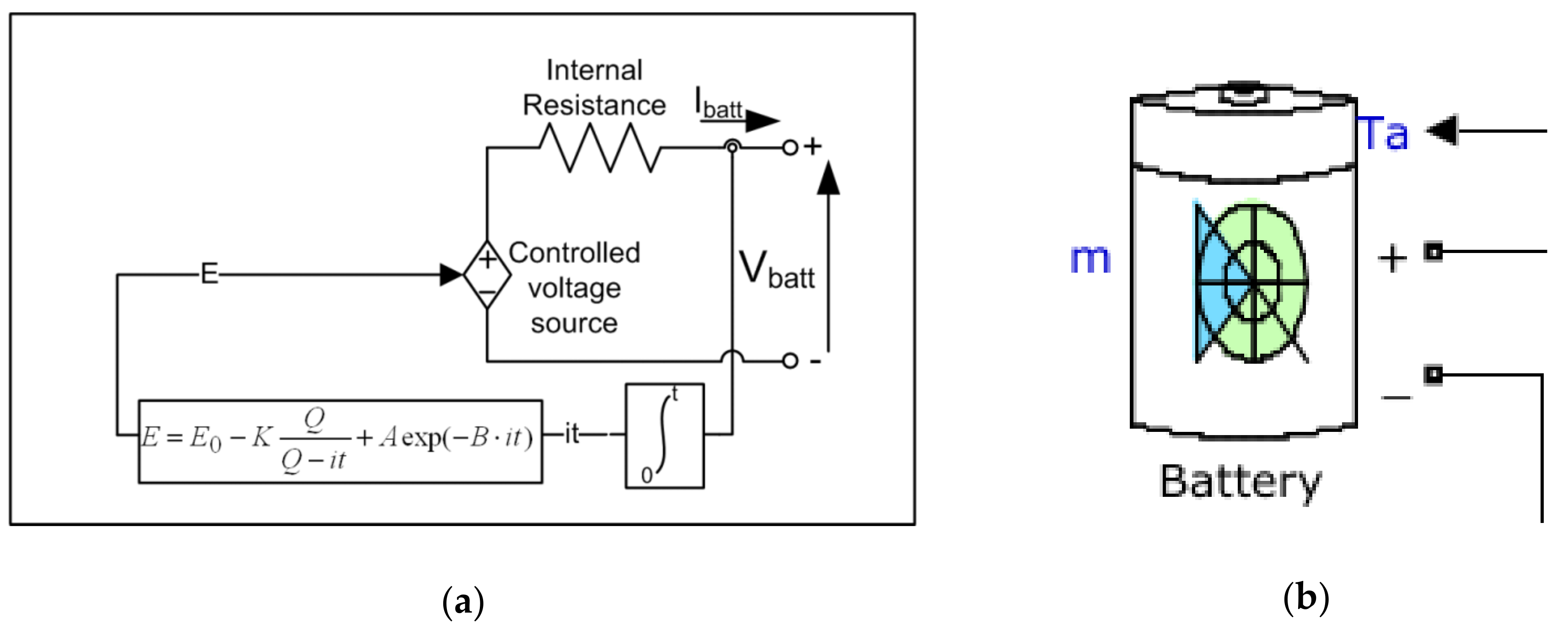
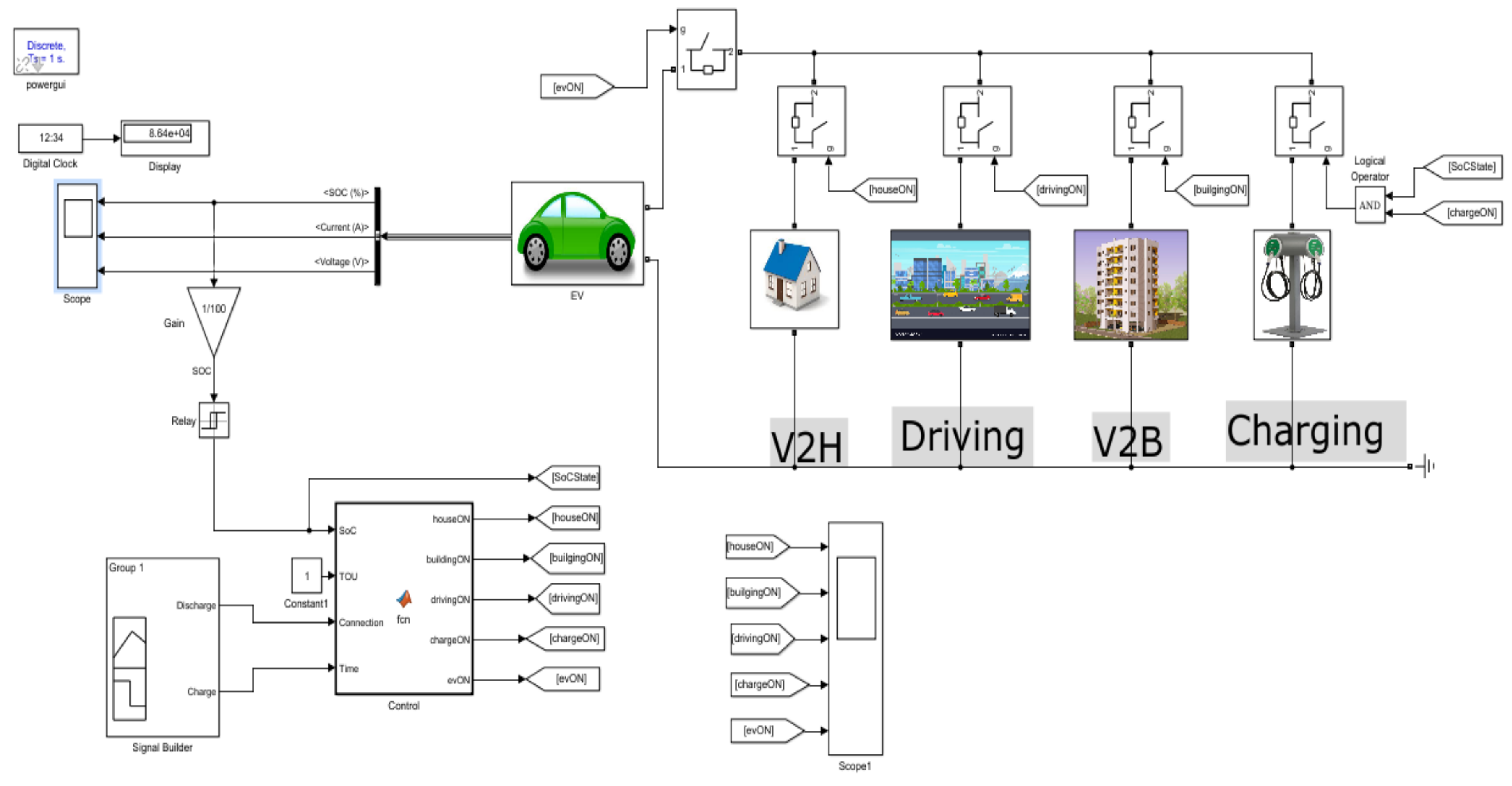
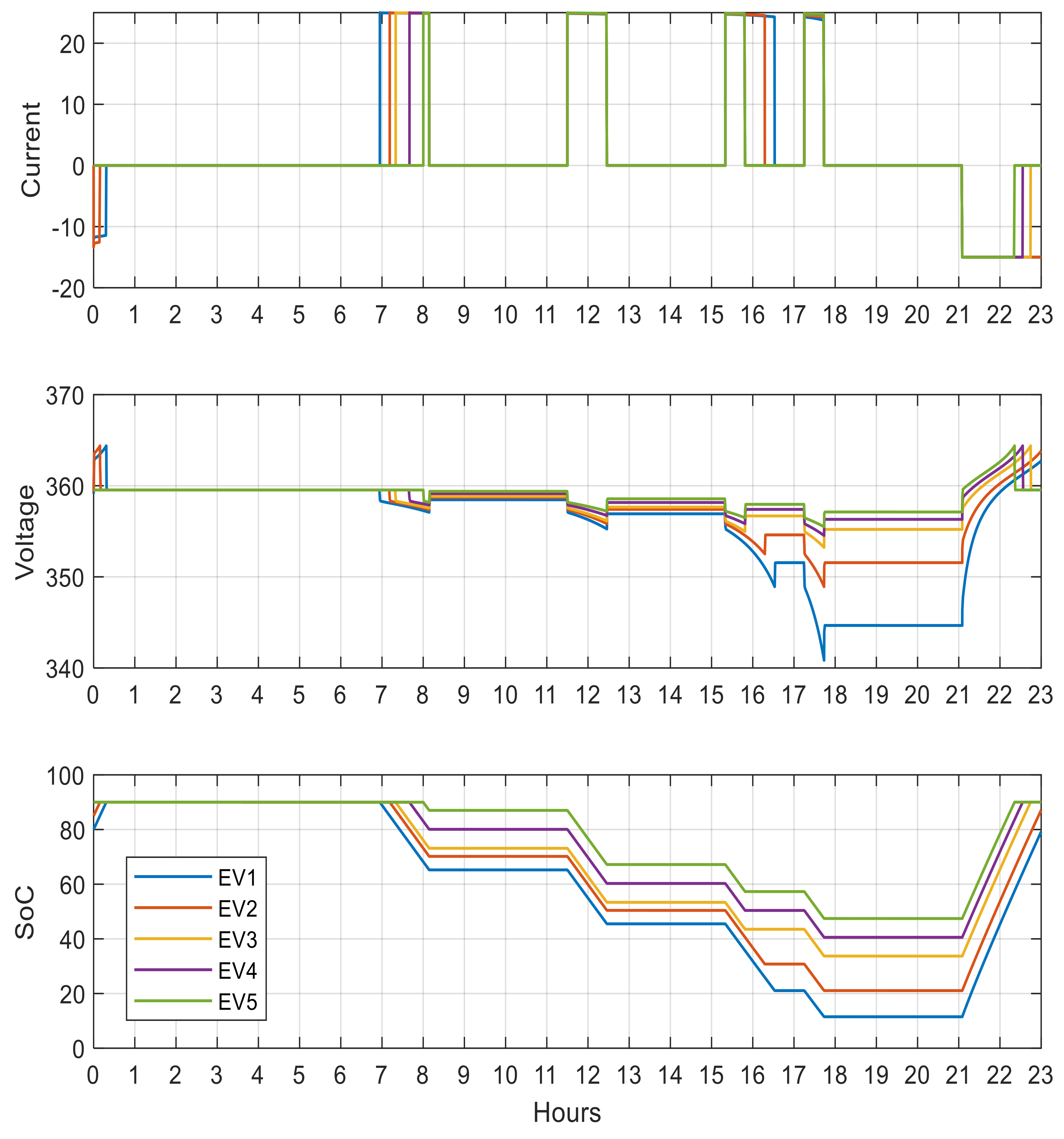
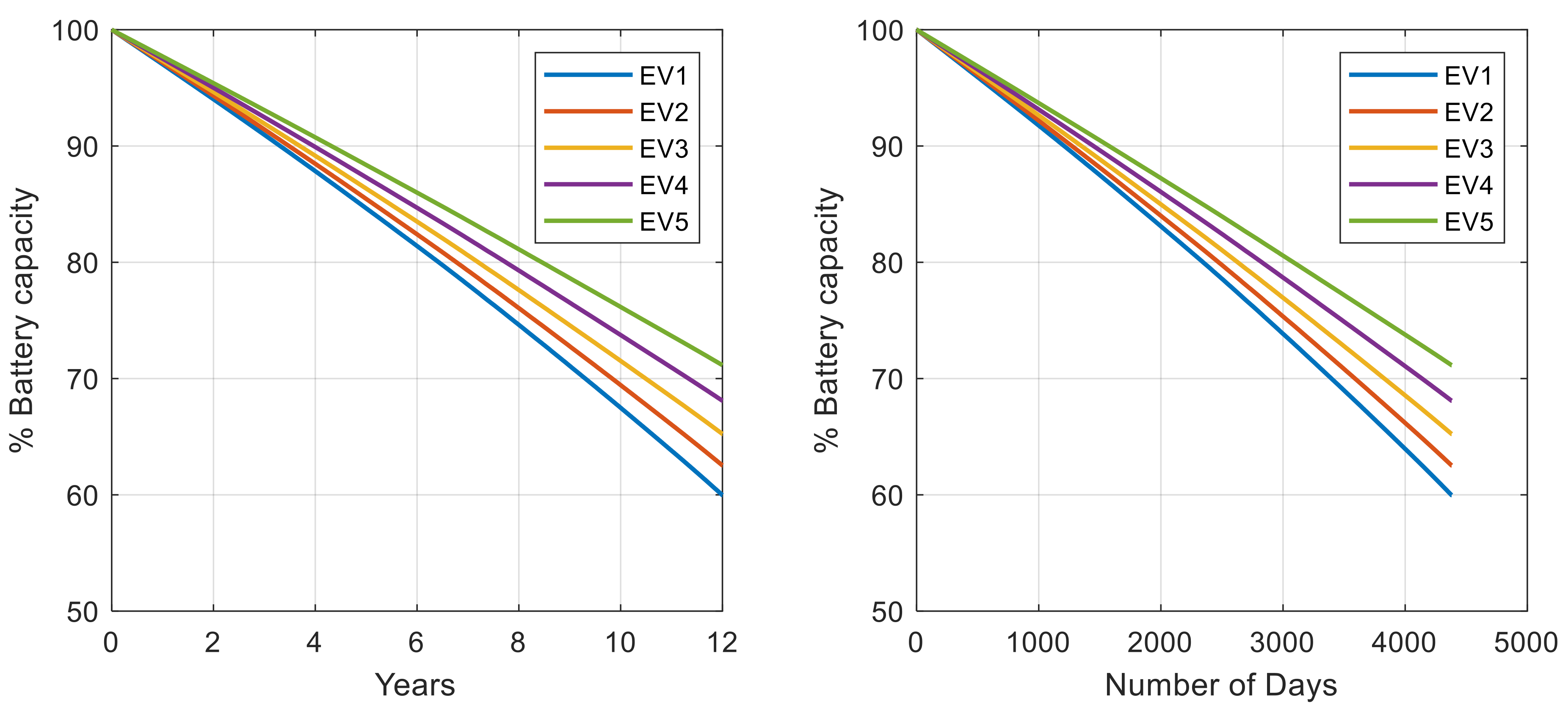
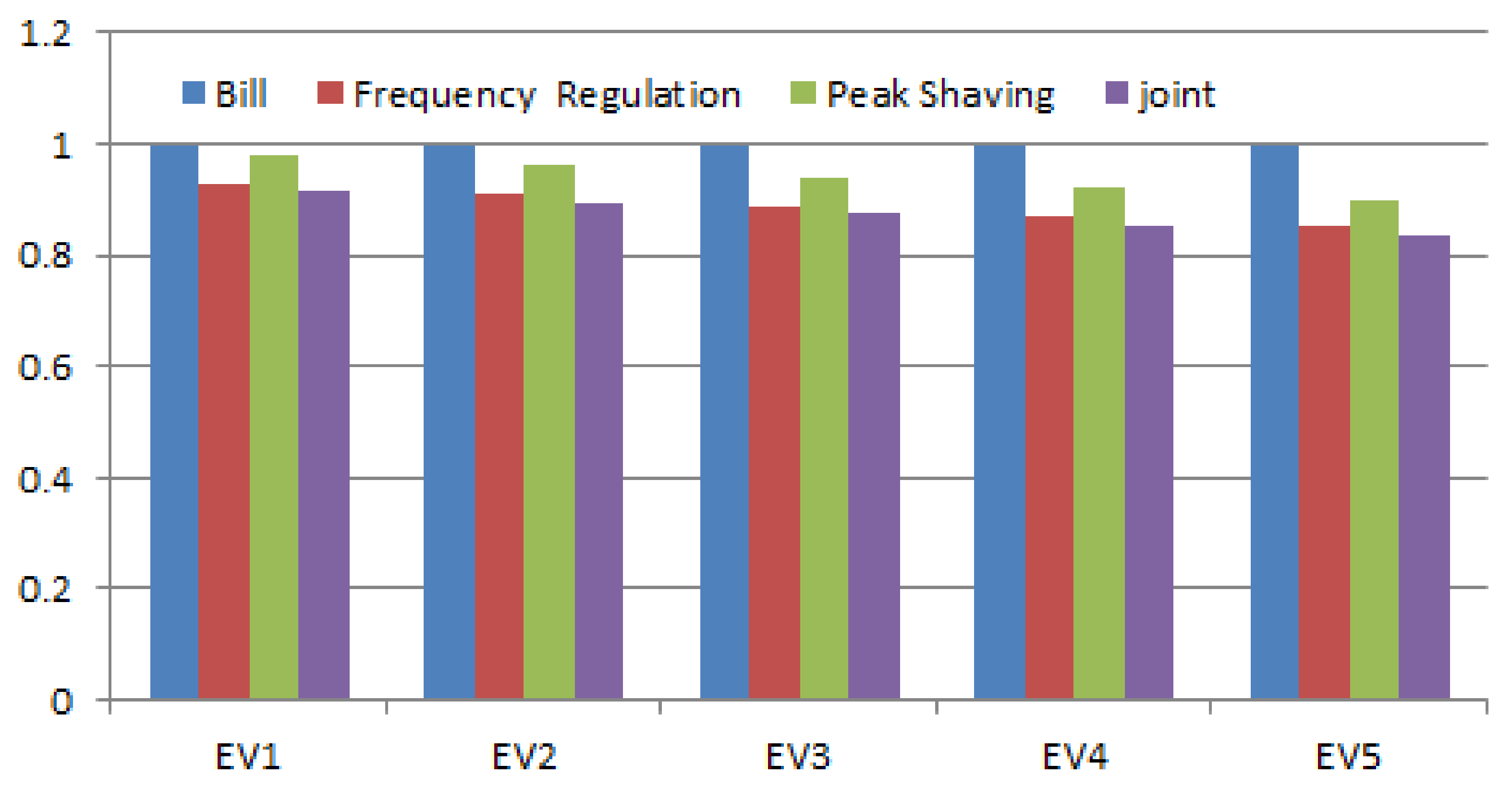

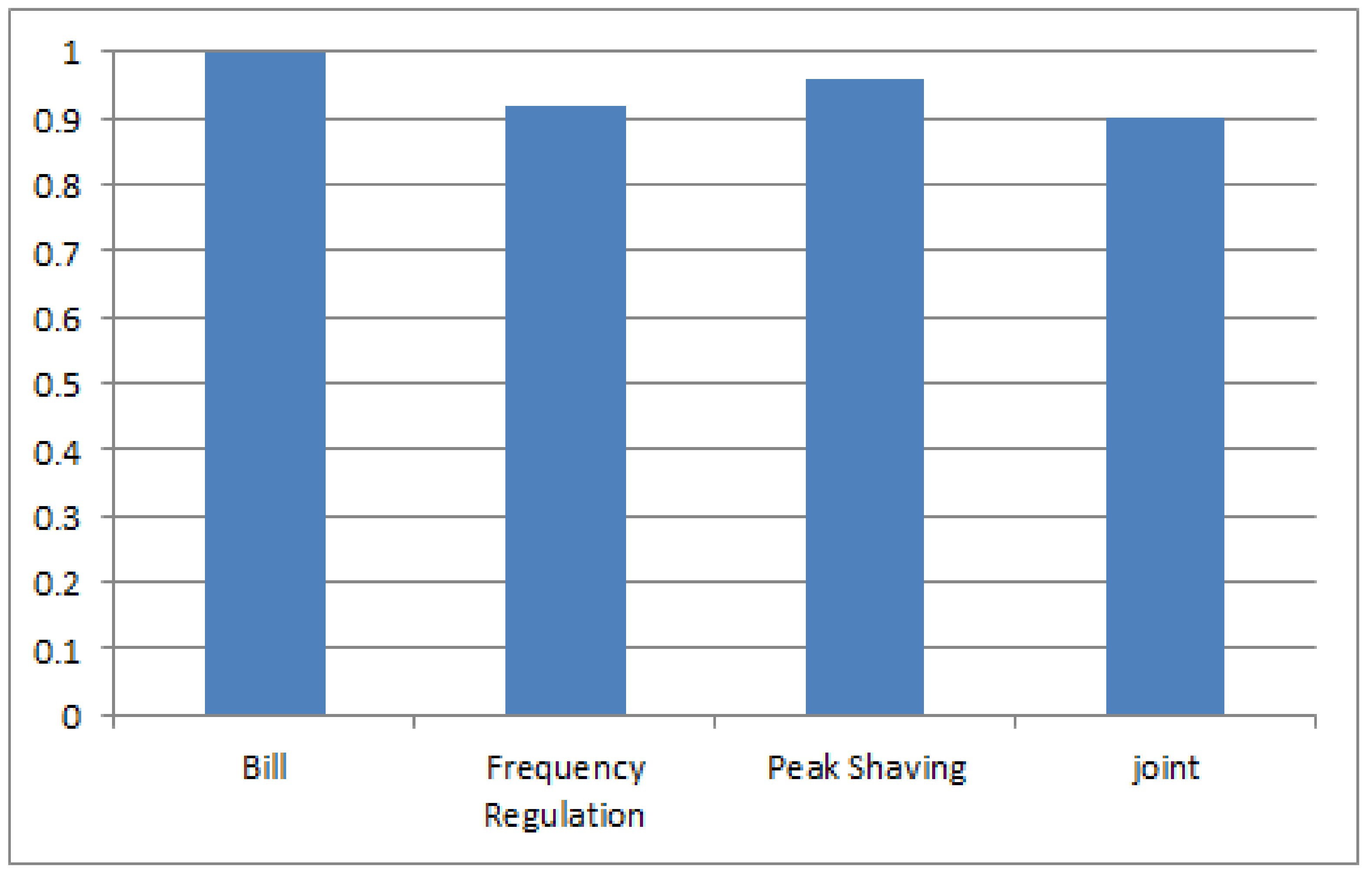
| Notations | Definitions |
|---|---|
| H | Daily electricity bill in $ |
| Helect | Daily off-peak electricity bill in $ |
| Hpeak | Daily on-peak electricity bill in $ |
| Ha | Adjusted electricity bill after peak shaving |
| αelec | energy price in $/MWh |
| αpeak | peak demand price in $/MW |
| r(t) | power consume at time t |
| rpeak | power consume during peak hours |
| bn(t) | Energy store in the nth battery |
| n(t) | The average power injection of the nth battery |
| N | Number of EVs |
| is the nth MBESS cell price $/Wh | |
| Kn | Number of cycles that the nth MBESS could be operated within |
| s(t) | The normalized frequency regulation signal |
| αc | Frequency regulation revenue |
| αmis | Frequency cost mismatch penalty |
| C | Power capacity |
| SoCmin | Min State of Charge |
| SoCt | Current State of Charge |
| SoCmax | Max State of Charge |
| cn | Frequency regulation capacity of each EV |
| Battery charging of the nth EV | |
| Discharging power of the nth EV | |
| y(t) | Frequency regulation load baseline |
| Battery capacity power of the nth EV |
© 2020 by the authors. Licensee MDPI, Basel, Switzerland. This article is an open access article distributed under the terms and conditions of the Creative Commons Attribution (CC BY) license (http://creativecommons.org/licenses/by/4.0/).
Share and Cite
Tchagang, A.; Yoo, Y. V2B/V2G on Energy Cost and Battery Degradation under Different Driving Scenarios, Peak Shaving, and Frequency Regulations. World Electr. Veh. J. 2020, 11, 14. https://doi.org/10.3390/wevj11010014
Tchagang A, Yoo Y. V2B/V2G on Energy Cost and Battery Degradation under Different Driving Scenarios, Peak Shaving, and Frequency Regulations. World Electric Vehicle Journal. 2020; 11(1):14. https://doi.org/10.3390/wevj11010014
Chicago/Turabian StyleTchagang, Alain, and Yeong Yoo. 2020. "V2B/V2G on Energy Cost and Battery Degradation under Different Driving Scenarios, Peak Shaving, and Frequency Regulations" World Electric Vehicle Journal 11, no. 1: 14. https://doi.org/10.3390/wevj11010014
APA StyleTchagang, A., & Yoo, Y. (2020). V2B/V2G on Energy Cost and Battery Degradation under Different Driving Scenarios, Peak Shaving, and Frequency Regulations. World Electric Vehicle Journal, 11(1), 14. https://doi.org/10.3390/wevj11010014





